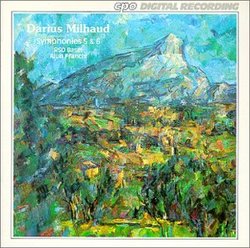| All Artists: Milhaud, Francis, Basel Radio Symphony Title: Symphonies 5 & 6 Members Wishing: 0 Total Copies: 0 Label: Cpo Records Release Date: 1/25/1995 Genre: Classical Styles: Historical Periods, Modern, 20th, & 21st Century, Symphonies Number of Discs: 1 SwapaCD Credits: 1 UPC: 761203906628 |
Search - Milhaud, Francis, Basel Radio Symphony :: Symphonies 5 & 6
 | Milhaud, Francis, Basel Radio Symphony Symphonies 5 & 6 Genre: Classical
|
Larger Image |
CD DetailsSimilar CDs
|
CD ReviewsThe supreme beauty of Milhaud's slow movements. A. Berenschot | 06/23/2000 (5 out of 5 stars) "The symphonies date from a more mature period of Darius Milhaud compositional life and confronts the listener with music he or she probably didn't expect if one is familiar with the more bizarre, witty, early music with its many influences by light music, like Le Boeuf sur le Toit and La Creation du Monde. The sixth symphony of Milhaud is definitively his greatest. It contains two slow and two fast movements. The slow movements (2/3rd of the music) are of an astonishing beauty! This music of wide open spaces is full of calmness, austerity, clarity, with beautiful changing harmonies and slowly spiralling melodies. The fast movements make a lively contrast to this. The fifth symphony contains one similar kind of slow movement of 14 minutes with a same supreme beauty. Overall the symphony is a little less balanced. After the third fast movement you don't really need the more or less similar fourth. Performance and recording are very good." A very enjoyable release G.D. | Norway | 03/30/2009 (4 out of 5 stars) "The cycle of Milhaud symphonies with the Basel Symphony Orchestra under Alun Francis doesn't seem to have garnered critical attention worthy of its importance. It is undeniably the case that Milhaud, being extremely prolific, sometimes lapsed into mere note-spinning, and the music is not "easy" in the sense of, say, his `Le Boeuf sur le Toit', being often polytonal, densely polyphonic and at times almost overly busy. But the symphonies are almost always surprisingly engaging, and more variegated than one might expect. The two works here are affable, neoclassical works of (mostly) high quality and level of invention. The fifth - Milhaud's longest symphony at barely above 32 minutes - is also one of the most interesting, contrasting understated, somewhat Stravinskian playfulness (and power) with exuberant swagger (with a fine, wistfully poignant and skillfully written second movement). The sixth, on the other hand, starts out lyrical and reflective with a becalmed, happy and thematically inventive first movement. It is followed by a boisterous second movement before swinging back to lyricism and again, in the final movement, to muscular and rather brusque jollity - in the last two movements the feeling of empty note-spinning isn't very far away, but the symphony as a whole is overall more than worthwhile. Performances are very good indeed, crisp and fresh and sharply focused, if not always quite ideally muscular and airy. Plasson on Deutsche Gramophon manages, perhaps, to bring out a little more lushness of texture in the sixth, but this performance isn't far inferior and possibly a little more spirited in the faster movements. CPO provides very good recorded sound; transparent, open and detailed." A Nice Discovery J. De Sapio | Washington, DC | 03/04/2006 (4 out of 5 stars) "Why are the contributions of the "Group of Six" (and particularly of Darius Milhaud and Arthur Honegger) to 20th-century music not given their due today? Their music is rarely performed in mainstream circles (indeed, the 20th-century repertoire seems to be deteriorating into a "hit parade" of popular pieces); popular reference books generally offer simplistic views of them, or pass over them as if they were minor creators. The average music lover's acquaintance with 20th-century music is often limited to such composers as Bartok, Prokofiev, and Shostakovich - not to belittle those composers, but I can't see why they are emphasized at the expense of others who hold a central place in 20th-century music.
So much for my tirade. I discovered this CD purely out of curiosity, and was immediately taken with these pastoral, plein-air chamber symphonies. They are full of Gallic lyricism, poetry, and delicate color shadings, in a free diatonic style spiced with polytonal writing. The reviewer below is right: the slow movements are indeed of an astonishing beauty. This luminescent, seamless, floating-cloud-formation music immediately brought to mind Honegger's great Third Symphony, and I'm sure many listeners will even be reminded at times of Copland. As to the performance: I was disturbed by some occasional thin tone and scrappy intonation in the violins (hence my 4-star rating), but this did not detract too much from the generally fine playing. (I liked the "rusty", broken tone quality in the solo oboist and violist.) Besides, one can't be picky, as this is apparently the only recording of these lovely gems (what did I expect?)." |

 Track Listings (8) - Disc #1
Track Listings (8) - Disc #1



